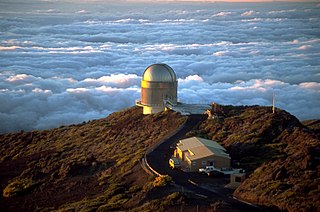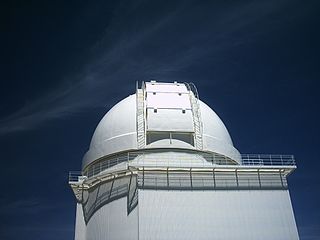
Prof Jacobus Cornelius Kapteyn FRS FRSE LLD was a Dutch astronomer. He carried out extensive studies of the Milky Way and was the discoverer of evidence for galactic rotation. Kapteyn was also among the first to suggest the existence of dark matter using stellar velocities as early as 1922.

The Gran Telescopio Canarias is a 10.4 m (410 in) reflecting telescope located at the Roque de los Muchachos Observatory on the island of La Palma, in the Canary Islands, Spain. It is the world's largest single-aperture optical telescope.

The Instituto de Astrofísica de Canarias (IAC) is an astrophysical research institute located in the Canary Islands, Spain. It was founded in 1975 at the University of La Laguna. It operates two astronomical observatories in the Canary Islands: Roque de los Muchachos Observatory on La Palma, and Teide Observatory on Tenerife.

The Isaac Newton Group of Telescopes or ING consists of three optical telescopes: the William Herschel Telescope, the Isaac Newton Telescope, and the Jacobus Kapteyn Telescope, operated by a collaboration between the UK Science and Technology Facilities Council, the Dutch NWO and the Spanish IAC. The telescopes are located at Roque de los Muchachos Observatory on La Palma in the Canary Islands.

The William Herschel Telescope (WHT) is a 4.20-metre (165 in) optical/near-infrared reflecting telescope located at the Roque de los Muchachos Observatory on the island of La Palma in the Canary Islands, Spain. The telescope, which is named after William Herschel, the discoverer of the planet Uranus, is part of the Isaac Newton Group of Telescopes. It is funded by research councils from the United Kingdom, the Netherlands and Spain.

The Isaac Newton Telescope or INT is a 2.54 m (100 in) optical telescope run by the Isaac Newton Group of Telescopes at Roque de los Muchachos Observatory on La Palma in the Canary Islands since 1984.

Roque de los Muchachos Observatory is an astronomical observatory located in the municipality of Garafía on the island of La Palma in the Canary Islands, Spain. The observatory site is operated by the Instituto de Astrofísica de Canarias, based on nearby Tenerife. ORM is part of the European Northern Observatory.

Teide Observatory, IAU code 954, is an astronomical observatory on Mount Teide at 2,390 metres (7,840 ft), located on Tenerife, Spain. It has been operated by the Instituto de Astrofísica de Canarias since its inauguration in 1964. It became one of the first major international observatories, attracting telescopes from different countries around the world because of the good astronomical seeing conditions. Later, the emphasis for optical telescopes shifted more towards Roque de los Muchachos Observatory on La Palma.

The ESA Optical Ground Station is the European Space Agency's ground based observatory at the Teide Observatory on Tenerife, Spain, built for the observation of space debris. OGS is part of the Artemis experiment and is operated by the IAC and Ataman Science S.L.U.
The Istituto di Radioastronomia di Bologna is one of research facilities of the Italian Istituto Nazionale di Astrofisica. Staff conduct research in astronomy, physics, engineering and information science. It was previously part of the Consiglio Nazionale delle Ricerche.

The National Astronomical Observatory is an astronomical observatory in Baja California, Mexico.

Teide 1 is a brown dwarf located ~430 light years away. It was the first brown dwarf to be verified, in 1995. Its surface temperature is 2,600 ± 150 K, which is about half that of the Sun. Its luminosity is 0.08–0.05% of that of the Sun. It is located in the Pleiades cluster, approximately 400 light-years (120 pc) from Earth, and is estimated to have about the same age as it, giving a plausible range from 70 to 140 Myr.

The Institute of Astrophysics of Andalusia is a research institute funded by the High Council of Scientific Research of the Spanish government Consejo Superior de Investigaciones Científicas (CSIC), and is located in Granada, Andalusia, Spain. IAA activities are related to research in the field of astrophysics, and instrument development both for ground-based telescopes and for space missions. Scientific research at the Institute covers the Solar System, star formation, stellar structure and evolution, galaxy formation and evolution and cosmology. The IAA was created as a CSIC research institute in July 1975. Presently, the IAA operates the Sierra Nevada Observatory, and the Calar Alto Observatory.

The Cherenkov Telescope Array or CTA is a multinational, worldwide project to build a new generation of ground-based gamma-ray instrument in the energy range extending from some tens of GeV to about 300 TeV. It is proposed as an open observatory and will consist of two arrays of imaging atmospheric Cherenkov telescopes (IACTs), a first array at the Northern Hemisphere with emphasis on the study of extragalactic objects at the lowest possible energies, and a second array at the Southern Hemisphere, which is to cover the full energy range and concentrate on galactic sources. The physics program of CTA goes beyond high energy astrophysics into cosmology and fundamental physics.
G 196-3 is a young low-mass M dwarf type star which is about 100 million years old. The star is located within the Ursa Major constellation about 71.1 light years away from the Earth. During observations by Instituto de Astrofísica de Canarias in Tenerife, Spain in 1998, a substellar-mass object was discovered to orbit approximately 300 astronomical units (AU) from the star. It was detected using direct imaging.
EURONEAR, the European Near Earth Asteroids Research, is a research project and network for the research and discovery of near-Earth objects and potentially hazardous asteroids using existing telescopes located in both hemispheres available to the members of the network. The Minor Planet Center directly credits EURONEAR with the discovery of few hundred minor planets since 2008, including 11 near-Earth asteroids.

The European Solar Telescope (EST) is a pan-European project to build a next-generation 4-metre class solar telescope, to be located at the Roque de los Muchachos Observatory in the Canary Islands, Spain. It will use state-of-the-art instruments with high spatial and temporal resolution that can efficiently produce two-dimensional spectral information in order to study the Sun's magnetic coupling between its deep photosphere and upper chromosphere. This will require diagnostics of the thermal, dynamic and magnetic properties of the plasma over many scale heights, by using multiple wavelength imaging, spectroscopy and spectropolarimetry.

The QUIJOTE CMB Experiment is an ongoing experiment started in November 2012, and led by Rafael Rebolo López, with the goal of characterizing the polarization of the cosmic microwave background (CMB) and other galactic and extragalactic emission in the frequency range 10 to 40 GHz, at angular scales of 1°. These measurements will complement at low frequency and correct from galactic contamination those obtained by the Planck satellite from 2009 to 2013.
Daniel Batcheldor is an Anglo-American astrophysicist, a former professor at Florida Institute of Technology and Head of the Department of Aerospace, Physics and Space Sciences, and Director of the Jacobus Kapteyn Telescope.

Donatiello I, also known as Mirach's Goblin, is a dwarf spheroidal galaxy in the constellation Andromeda, located between 8.1 and 11.4 million light-years from Earth. It is a possible satellite galaxy of the dwarf lenticular galaxy NGC 404, "Mirach's Ghost", which is situated 60 arcminutes away. It is otherwise one of the most isolated dwarf spheroidal galaxies known, being separated from NGC 404 by around 211,000 light-years. The galaxy is named after its discoverer, amateur astrophotographer Giuseppe Donatiello, who sighted the galaxy in a 2016 review of his archival long exposures from 2010 and 2013. Follow-up observations with the Roque de los Muchachos Observatory led to a scientific paper on its discovery being published in December 2018.

















